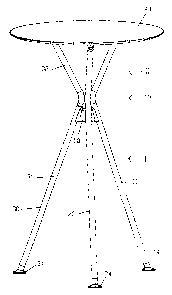Une partie des informations de ce site Web a été fournie par des sources externes. Le gouvernement du Canada n'assume aucune responsabilité concernant la précision, l'actualité ou la fiabilité des informations fournies par les sources externes. Les utilisateurs qui désirent employer cette information devraient consulter directement la source des informations. Le contenu fourni par les sources externes n'est pas assujetti aux exigences sur les langues officielles, la protection des renseignements personnels et l'accessibilité.
L'apparition de différences dans le texte et l'image des Revendications et de l'Abrégé dépend du moment auquel le document est publié. Les textes des Revendications et de l'Abrégé sont affichés :
| (12) Demande de brevet: | (11) CA 2606209 |
|---|---|
| (54) Titre français: | TABLE PLIANTE |
| (54) Titre anglais: | FOLDING TABLE |
| Statut: | Réputée abandonnée et au-delà du délai pour le rétablissement - en attente de la réponse à l’avis de communication rejetée |
| (51) Classification internationale des brevets (CIB): |
|
|---|---|
| (72) Inventeurs : |
|
| (73) Titulaires : |
|
| (71) Demandeurs : |
|
| (74) Agent: | MARKS & CLERK |
| (74) Co-agent: | |
| (45) Délivré: | |
| (22) Date de dépôt: | 2007-10-09 |
| (41) Mise à la disponibilité du public: | 2008-04-23 |
| Requête d'examen: | 2008-08-21 |
| Licence disponible: | S.O. |
| Cédé au domaine public: | S.O. |
| (25) Langue des documents déposés: | Anglais |
| Traité de coopération en matière de brevets (PCT): | Non |
|---|
| (30) Données de priorité de la demande: | ||||||
|---|---|---|---|---|---|---|
|
For a table with three legs (10, 20, 30) and a table surface (40) which folds
down, said
table also standing on its three legs when the table surface is folded down,
and the legs
run together toward the table surface in a lower region (I), the invention
specifies that
the legs diverge at a slant from each other toward the table surface in an
upper region
(II), two of the three legs (10, 20) are joined to the table surface by
tilting linkages and
the third leg (30) is composed of a lower (31) and an upper part (32), while
the upper
part (32) comprises the upper region of the third leg, is detachably joined to
the table
surface, and can turn relative to the lower part.
Note : Les revendications sont présentées dans la langue officielle dans laquelle elles ont été soumises.
Note : Les descriptions sont présentées dans la langue officielle dans laquelle elles ont été soumises.

2024-08-01 : Dans le cadre de la transition vers les Brevets de nouvelle génération (BNG), la base de données sur les brevets canadiens (BDBC) contient désormais un Historique d'événement plus détaillé, qui reproduit le Journal des événements de notre nouvelle solution interne.
Veuillez noter que les événements débutant par « Inactive : » se réfèrent à des événements qui ne sont plus utilisés dans notre nouvelle solution interne.
Pour une meilleure compréhension de l'état de la demande ou brevet qui figure sur cette page, la rubrique Mise en garde , et les descriptions de Brevet , Historique d'événement , Taxes périodiques et Historique des paiements devraient être consultées.
| Description | Date |
|---|---|
| Le délai pour l'annulation est expiré | 2011-10-11 |
| Demande non rétablie avant l'échéance | 2011-10-11 |
| Réputée abandonnée - les conditions pour l'octroi - jugée non conforme | 2010-10-13 |
| Réputée abandonnée - omission de répondre à un avis sur les taxes pour le maintien en état | 2010-10-12 |
| Un avis d'acceptation est envoyé | 2010-04-13 |
| Lettre envoyée | 2010-04-13 |
| Un avis d'acceptation est envoyé | 2010-04-13 |
| Inactive : Certificat de dépôt - RE (Anglais) | 2010-04-09 |
| Inactive : Approuvée aux fins d'acceptation (AFA) | 2010-03-16 |
| Inactive : Demandeur supprimé | 2009-08-10 |
| Modification reçue - modification volontaire | 2009-07-23 |
| Lettre envoyée | 2008-10-20 |
| Exigences pour une requête d'examen - jugée conforme | 2008-08-21 |
| Toutes les exigences pour l'examen - jugée conforme | 2008-08-21 |
| Requête d'examen reçue | 2008-08-21 |
| Demande publiée (accessible au public) | 2008-04-23 |
| Inactive : Page couverture publiée | 2008-04-22 |
| Demande de correction du demandeur reçue | 2008-03-17 |
| Inactive : CIB en 1re position | 2008-02-05 |
| Inactive : CIB attribuée | 2008-02-05 |
| Inactive : Certificat de dépôt - Sans RE (Anglais) | 2007-11-23 |
| Exigences de dépôt - jugé conforme | 2007-11-23 |
| Lettre envoyée | 2007-11-23 |
| Demande reçue - nationale ordinaire | 2007-11-19 |
| Date d'abandonnement | Raison | Date de rétablissement |
|---|---|---|
| 2010-10-13 | ||
| 2010-10-12 |
Le dernier paiement a été reçu le 2009-10-07
Avis : Si le paiement en totalité n'a pas été reçu au plus tard à la date indiquée, une taxe supplémentaire peut être imposée, soit une des taxes suivantes :
Veuillez vous référer à la page web des taxes sur les brevets de l'OPIC pour voir tous les montants actuels des taxes.
| Type de taxes | Anniversaire | Échéance | Date payée |
|---|---|---|---|
| Taxe pour le dépôt - générale | 2007-10-09 | ||
| Requête d'examen - générale | 2008-08-21 | ||
| TM (demande, 2e anniv.) - générale | 02 | 2009-10-09 | 2009-10-07 |
Les titulaires actuels et antérieures au dossier sont affichés en ordre alphabétique.
| Titulaires actuels au dossier |
|---|
| SEDUS STOLL AKTIENGESELLSCHAFT |
| Titulaires antérieures au dossier |
|---|
| SIEGFRIED DONNER |
| TOBIAS WEISSENRIEDER |